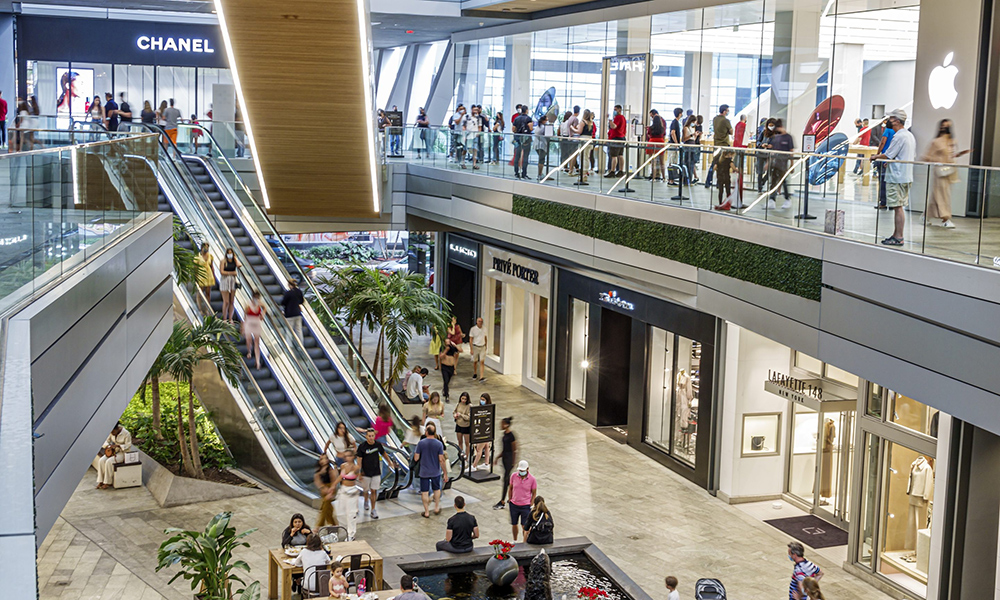
如果你在為自己喜愛的一些品牌的破產而難過,那么你就需要知道:事實證明,這也許正是你附近的購物中心的燈還亮著的原因。
長期以來,人們一直認為實體零售業正在被在線零售巨頭擠出市場,但一份最新的報告發現,一些購物中心的經營狀況實際上比新冠疫情前還要好。
美國的消費者似乎很是思念闊別已久的購物中心,零售業咨詢機構Coresight Research的數據顯示,他們現在其實比新冠疫情前更經常光顧當地的購物中心。
在所謂的高檔購物中心(即提供奢侈品零售服務和入駐了重要新品牌的購物中心)以及中低檔購物中心(即迎合較低收入消費者需求的購物中心),客流量均有所上升。
高檔購物中心的客流量上漲了12%,低檔購物中心的客流量則上漲了10%。
與此同時,購物中心的入駐率也恢復良好。
最高檔次的購物中心的入駐率回升至95.1%,僅比新冠疫情前低0.1%;其他購物中心的入駐率為89.1%,而新冠疫情前為91.6%。
但據專家稱,購物中心零售商組合的微小變化實際上可能是好事。
世邦魏理仕(CBRE)的美洲零售研究主管布蘭登·伊斯納對美國有線電視新聞網(CNN)表示:“對于那些喜歡逛購物中心的人來說,他們會希望每隔一段時間就有一些新店。”
“再想到Bed Bath & Beyond目前還在騰出零售空間,這其實對零售業而言是好事一樁。”
伊斯納稱,房東們很高興能夠收回這些零售空間,因為如此一來他們就可以收取更高的租金,同時想打入市場的新零售商也獲得了機會。
根據針對公共購物中心運營商提供的數據的研究,高檔購物中心與非高檔購物中心的總收入均實現增長。
奢侈品熱潮
得益于常年入駐其中的知名品牌的熱潮,高檔購物中心可能表現更佳。
消費者似乎并沒有被對通脹或者日益迫近的衰退的擔憂嚇退,依然在名牌服裝上大肆揮霍。
全球最大的時尚品牌路威酩軒(LVMH),即酩悅·軒尼詩-路易·威登集團(Mo?t Hennessy Louis Vuitton),2023年上半年的業績“相當理想”。
今年7月,這家由世界第二富豪貝爾納·阿爾諾擁有的集團公布,該集團2023年上半年的收入為422億歐元(約457億美元),同比增長15%,而有機收入同比增長17%。
除需求保持強勁外,奢侈品消費者還呈現出年輕化的趨勢。
根據最新發布的《貝恩公司-意大利奢侈品行業協會奢侈品研究》(Bain & Company–Altagamma Luxury Study),2022年,Y世代(1982年至1994年出生的一代,也被稱為千禧一代)和Z世代(20世紀90年代中期至21世紀00年代中期出生的一代)貢獻了奢侈品市場全部的增長。
該報告指出,由于Z世代從15歲起就開始迷上了高價商品,而他們的后繼者Alpha世代預計也會如此,到本個十年末,個人奢侈品市場市值將攀升至約5,400億歐元至5,800億歐元(約5,850億美元至6,280億美元),與2022年相比增長至少60%。
光環效應
事實證明,那些接納在線零售商而非與之對抗的購物中心不僅存活了下來,還在蓬勃發展。
零售業分析機構Coresight Research表示,發展多渠道的零售方式對現代零售業來說是“必要的”,并稱進入實體店在線零售商(進入在線零售市場的實體店零售商亦然)共同形成了“光環效應”。
Brookfield Property Group、Macerich、西蒙房地產集團(Simon Property Group)及Taubman Centers等高檔零售購物中心的運營商都報告了這一趨勢,稱消費者正在返回實體店和恢復在線購物。
在今年6月的最新財報電話會議上,Macerich的首席執行官湯姆·奧赫恩說:“租賃量依然保持在歷史最高值。我們的入駐率相比去年同期增長了80個基點,較上一季度環比增長了40個基點。”
“消費者的購物、外出就餐和旅行消費都達到了新冠疫情前的水平。”(財富中文網)
譯者:中慧言-劉嘉歡
如果你在為自己喜愛的一些品牌的破產而難過,那么你就需要知道:事實證明,這也許正是你附近的購物中心的燈還亮著的原因。
長期以來,人們一直認為實體零售業正在被在線零售巨頭擠出市場,但一份最新的報告發現,一些購物中心的經營狀況實際上比新冠疫情前還要好。
美國的消費者似乎很是思念闊別已久的購物中心,零售業咨詢機構Coresight Research的數據顯示,他們現在其實比新冠疫情前更經常光顧當地的購物中心。
在所謂的高檔購物中心(即提供奢侈品零售服務和入駐了重要新品牌的購物中心)以及中低檔購物中心(即迎合較低收入消費者需求的購物中心),客流量均有所上升。
高檔購物中心的客流量上漲了12%,低檔購物中心的客流量則上漲了10%。
與此同時,購物中心的入駐率也恢復良好。
最高檔次的購物中心的入駐率回升至95.1%,僅比新冠疫情前低0.1%;其他購物中心的入駐率為89.1%,而新冠疫情前為91.6%。
但據專家稱,購物中心零售商組合的微小變化實際上可能是好事。
世邦魏理仕(CBRE)的美洲零售研究主管布蘭登·伊斯納對美國有線電視新聞網(CNN)表示:“對于那些喜歡逛購物中心的人來說,他們會希望每隔一段時間就有一些新店。”
“再想到Bed Bath & Beyond目前還在騰出零售空間,這其實對零售業而言是好事一樁。”
伊斯納稱,房東們很高興能夠收回這些零售空間,因為如此一來他們就可以收取更高的租金,同時想打入市場的新零售商也獲得了機會。
根據針對公共購物中心運營商提供的數據的研究,高檔購物中心與非高檔購物中心的總收入均實現增長。
奢侈品熱潮
得益于常年入駐其中的知名品牌的熱潮,高檔購物中心可能表現更佳。
消費者似乎并沒有被對通脹或者日益迫近的衰退的擔憂嚇退,依然在名牌服裝上大肆揮霍。
全球最大的時尚品牌路威酩軒(LVMH),即酩悅·軒尼詩-路易·威登集團(Mo?t Hennessy Louis Vuitton),2023年上半年的業績“相當理想”。
今年7月,這家由世界第二富豪貝爾納·阿爾諾擁有的集團公布,該集團2023年上半年的收入為422億歐元(約457億美元),同比增長15%,而有機收入同比增長17%。
除需求保持強勁外,奢侈品消費者還呈現出年輕化的趨勢。
根據最新發布的《貝恩公司-意大利奢侈品行業協會奢侈品研究》(Bain & Company–Altagamma Luxury Study),2022年,Y世代(1982年至1994年出生的一代,也被稱為千禧一代)和Z世代(20世紀90年代中期至21世紀00年代中期出生的一代)貢獻了奢侈品市場全部的增長。
該報告指出,由于Z世代從15歲起就開始迷上了高價商品,而他們的后繼者Alpha世代預計也會如此,到本個十年末,個人奢侈品市場市值將攀升至約5,400億歐元至5,800億歐元(約5,850億美元至6,280億美元),與2022年相比增長至少60%。
光環效應
事實證明,那些接納在線零售商而非與之對抗的購物中心不僅存活了下來,還在蓬勃發展。
零售業分析機構Coresight Research表示,發展多渠道的零售方式對現代零售業來說是“必要的”,并稱進入實體店在線零售商(進入在線零售市場的實體店零售商亦然)共同形成了“光環效應”。
Brookfield Property Group、Macerich、西蒙房地產集團(Simon Property Group)及Taubman Centers等高檔零售購物中心的運營商都報告了這一趨勢,稱消費者正在返回實體店和恢復在線購物。
在今年6月的最新財報電話會議上,Macerich的首席執行官湯姆·奧赫恩說:“租賃量依然保持在歷史最高值。我們的入駐率相比去年同期增長了80個基點,較上一季度環比增長了40個基點。”
“消費者的購物、外出就餐和旅行消費都達到了新冠疫情前的水平。”(財富中文網)
譯者:中慧言-劉嘉歡
If you’re sad to see some of your favorite brands going bust, it turns out that might be the reason the lights are still on at your nearby shopping mall.
Contrary to a long-held opinion that brick-and-mortar retail is being muscled out by online giants, a new report has found that some shopping centers are actually faring even better than before the pandemic.
Absence seems to have made the heart grow fonder for American shoppers, with the data from Coresight Research revealing that consumers are actually using their local malls more than they were before the pandemic.
Across so-called top-tier malls—those which offer luxury retail as well as new and noteworthy brands—and mid- and lower-tier malls—which cater to lower-income shoppers—footfall is up.
For top-tier malls, the number of visitors is up 12%, while lower-tiered malls are up 10%.
Meanwhile, occupancy has also recovered well.
In the highest-quality malls, occupancy is back up to 95.1%, just 0.1% lower than before the pandemic, and in other malls the figure stands at 89.1% compared to 91.6% before the pandemic.
However, a bit of turnover on the lineup in shopping centers might actually be a good thing, according to experts.
“For people who go to the malls, they’re going to want some fresh new stores every once in a while,” Brandon Isner, CBRE’s head of retail research for the Americas, told CNN.
“Take into account the Bed Bath & Beyond retail space that’s being vacated as we speak—it’s turning out that’s actually kind of a good thing for retail.”
Isner said that landlords are pleased to have the space back so they can charge higher rents, while it also frees up opportunities for new retailers trying to break into the market.
Total revenue is also up in both top-tier and non-top-tier malls, according to the research which gathered data from public mall operators.
A boom in luxury
Higher-end malls may be faring better courtesy of the famous brands which call their centers home.
Seemingly undeterred by fears of inflation or a looming recession, shoppers are continuing to splash out on designer gear.
LVMH—Mo?t Hennessy Louis Vuitton—the world’s biggest designer fashion house, reported an “excellent” first half of 2023.
In July the group, owned by the world’s second-richest man Bernard Arnault, reported revenue of €42.2 billion ($45.7 billion) in the first half of 2023, up 15%, while organic revenue growth was 17% compared to the same period in 2022.
And as well as seeing continuing demand, luxury shoppers are only getting younger.
According to the latest Bain & Company–Altagamma Luxury Study, Gen Y—those born between 1982 and 1994, also known as millennials—and Gen Z—those born from the mid-’90s to the mid-’00s—accounted for the entire growth of the luxury market in 2022.
With Gen Z already hooked on high-ticket items from the age of 15—and their successors Generation Alpha expected to do the same according to the report—the personal luxury market is set to climb to around €540–€580 billion ($585 to $628 billion) by the end of the decade, a rise of 60% or more compared to 2022.
The halo effect
It turns out malls that are embracing online retailers instead of fighting them are also the ones that are not only surviving but thriving.
Coresight Research said developing a multi-channel approach to sales is a “necessity” of modern retail, and dubbed the combination of online retailers moving into physical stores—and vice versa—the “halo effect.”
Top-tier retail mall operators like Brookfield Property Group, Macerich, Simon Property Group, and Taubman Centers have all reported such a trend, saying consumers are returning to stores as well as shopping online.
During its most recent earnings call in June Tom O’Hern, CEO of Macerich, said: “Leasing volumes [have] continued at a record level. We had an 80-basis-point gain in occupancy compared to a year ago and 40-basis-point gain compared to last quarter.
“Consumers are shopping, eating out, and traveling at pre-pandemic levels.”






